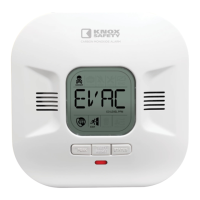WHAT LEVELS OF CO CAUSE AN ALARM?
Underwriters Laboratories Inc. Standard UL2034 requires residential CO
alarms to sound when exposed to the levels of CO and exposure times as
described below. They are measured in parts per million (ppm) of CO over
time (in minutes).
UL2034 Required Alarm Points*:
• If the alarm is exposed to 400 ppm of CO, IT MUST ALARM BETWEEN
4 and 15 MINUTES.
• If the alarm is exposed to 150 ppm of CO, IT MUST ALARM BETWEEN
10 and 50 MINUTES.
• If the alarm is exposed to 70 ppm if CO, IT MUST ALARM BETWEEN
60 and 240 MINUTES.
*Approximately 10% COHb exposure at levels of 10% to 95% Relative
Humidity (RH). The unit is designed not to alarm when exposed to a
constant level of 30 ppm for 30 days.
IMPORTANT!
CO alarms are designed to alarm before there is an immediate life threat.
Since you cannot see or smell CO, never assume it's not present. An
exposure to 100 ppm of CO for 20 minutes may not affect average, healthy
adults, but after 4 hours the same level may cause headaches. An exposure
to 400 ppm of CO may cause headaches in average, healthy adults after 35
minutes, but can cause death after 2 hours.
Standards: Underwriters Laboratories Inc. Single and Multiple
Station Carbon Monoxide Alarms UL2034.
According to Underwriters Laboratories Inc. UL2034, Section 1-1. 2:
"Carbon monoxide alarms covered by these requirements are intended to
respond to the presence of carbon monoxide from sources such as, but not
limited to: exhaust from internal-combustion engines, abnormal operation
of fuel-fired appliances, and fireplaces. CO alarms are intended to alarm at
carbon monoxide levels below those that could cause a loss of ability to
react to the dangers of carbon monoxide exposure. This CO alarm
monitors the air at the alarm and is designed to alarm before CO levels
become life threatening. This allows you precious time to leave the house
and correct the problem. This is only possible if alarms are located,
installed, and maintained as described in this manual.
Gas Detection at Typical Temperature and Humidity Ranges: A CO alarm
is not formulated to detect CO levels below 30 ppm typically. UL tested for
false alarm resistance to Methane (500 ppm), Butane (300 ppm), Heptane
(500 ppm), Ethyl Acetate (200 ppm), Isopropyl Alcohol (200 ppm) and
Carbon Dioxide (5000 ppm). Values measure gas and vaporconcentrations
in parts per million.
Audible Alarm: 85 dB minimum at 10 feet (3 meters).
REGULATORY INFORMATION FOR CO ALARMS
16

